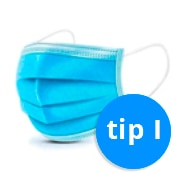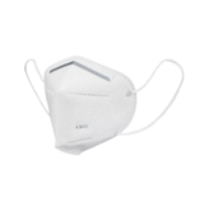Differences between masks FFP1 - FFP2 - FFP3 - KN95! Guide on how to choose the right protective mask for you.
We've been trapped in a pandemic for about two years now protective mask. Most countries have adopted restrictive measures and travel rules that involve wearing a mask and physical distance to slow down / stop the spread of the new coronavirus.
The rule of wearing the mask applies outdoors, to the store, to the market, to the workplace, to public transportation, in most vacancies. For example, there are airlines that have asked passengers to wear a certain type of mask. The most requested are the FFP3 ones, others require KN95 type masks.
Protective masks have a dual role: they protect us from virus infection (as much as possible); prevents us from removing viruses in the air (we protect those around us). It is true that the mask is not applied tightly on the face, but it is an extra protection against viruses. Any protective measures increase our chances of being infected with the new coronavirus or any other virus in the atmosphere. There are dozens of models of masks on the market divided into 4 main categories.
Before buy protective masks, search / request product information. Take into account not only the price, but also its specifications and the level of protection offered. It should be noted that it is recommended to wear medical / surgical and respiratory masks with 3-4-5 layers.
 See the Offers!
See the Offers!  See the Offers!
See the Offers!  See the Offers!
See the Offers!  See the Offers!
See the Offers! Medical / surgical / facial masks have 3 layers and are of three types:
- type I - 95% efficiency
- type II - 98% efficiency
- type III - 98% efficiency + splash protection - standard EN14683
Respiratory masks with 3-4-5 layers are of three types:
- FFP1 - three layers - 80% efficiency
- FFP2 / KN95 / KF94 - four layers - 94% efficiency
- FFP3 / KN99 - four or five layers - 99% efficiency
 |  |  |  |  | |
|---|---|---|---|---|---|
| Mask type | Simple facial | Medical type I | Medical type II | KN95, FFP2, N95 | KN99, FFP3, N99 |
| Number of layers | 3 layers | 3 layers | 3 layers | 4 layers | 4 layers |
| EU quality standard | ✔︎ EN 149: 2001 | ✔︎ EN 14683, type I | ✔︎ EN 14683, type II | ✔︎ EN 149: 2001 | ✔︎ EN 149: 2001 |
| Dust filtering | ✔︎ | ✔︎ | ✔︎ | ✔︎ | ✔︎ |
| Bacterial protection efficiency | ❌ | ✔︎ | ✔︎ | ✔︎ | ✔︎ |
| Filter particle size (microns) | 3 | 3 | 3 | 0.3 | 0.3 |
| Filtering efficiency | ≥ 80% | ≥ 95% | ≥ 98% | ≥ 94% | ≥ 99% |
| WATERTIGHT | ❌ | ❌ | ❌ | ✔︎ | ✔︎ |
| PFE (dust particle) filtration efficiency | Standard | Standard | Standard | Superior | Superior |
| BFE (bacteria) filtration efficiency | ❌ | Standard | Standard | Superior | Superior |
| Protection against inhaled particles | ✔︎ | ✔︎ | ✔︎ | ✔︎ | ✔︎ |
| Protection against expired particles | ❌ | ✔︎ | ✔︎ | ✔︎ | ✔︎ |
| Accredited testing according to European quality standards | ✔︎ | ✔︎ | ✔︎ | ✔︎ | ✔︎ |
| European certification as a medical device | ❌ | ✔︎ | ✔︎ | ❌ | ❌ |
 See the Offers!
See the Offers!  See the Offers!
See the Offers!  See the Offers!
See the Offers!  See the Offers!
See the Offers! Most commercially available masks are non-sterile and disposable. If you want masks to ensure your sealing, then you can opt for the FFP2 / FFP3 type. If you want masks for temporary wear, with a minimum of protection, you can opt for medical type I or type II.
Textile masks of cotton or other fabric, with 1, 2 or even 3 layers, they do NOT have any protection against viruses. These are not part of the COVID 19 protection kit! They are a compromise (better than nothing).
The choice of a protective mask should be made taking into account several factors including: the requirements of the authorities, the level of protection, the quality of materials and, of course, the price. Watch out for fake masks!

